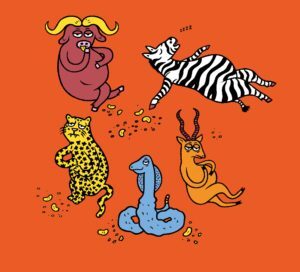For me, risk-taking and adventure are the heart of good publishing, good book buying (and selling) and good reading; these things all belong together.
For me, diversity means not-sameness. A diet of one thing becomes tiring in the end, in the way that cabbage is very good as a vegetable, but not if you are on an all-cabbage diet. One does need cake.
When I started Gecko Press, I thought I should choose books that no one would know came from another place, books that would just blend in. But when I showed a top-selling book from Sweden to a Wellington librarian, she asked why she should buy a book like that from Gecko Press when there was a perfectly good local one already?
From that point I decided Gecko Press would actively choose books unlike anything else we could see in the English market: books that feel original and fresh and different – the beginning of what we call ‘curiously good books’.
When we are choosing a book at Gecko Press, if any of us think we have seen one like this already, then the choice will be a No.
When Gecko Press began in 2005, one percent of books published in the UK were from non-English languages. When I reported this number to the Swedish publisher of Margaret Mahy, he said: “I’m surprised that figure is so high.” By 2019, this figure had risen to 5.63% and it continues to rise, according to Nielsen Book and the International Booker Prize committee. There is certainly now a larger appetite for books outside the norm. Still, in Europe, translated books are much higher, around 40% of the market.
Back then, I didn’t know that books in the English-language world were any different from those from other countries. And I didn’t know anything about what not to publish. I didn’t know that you couldn’t do books about death, for example.
When we released Duck, Death and the Tulip by Wolf Erlbruch, seventy librarians in New Zealand went on a listserv to discuss it. Comments ranged from “Does anyone else hate this book?” to stories of children taking it to the playground and home to their families. My father said that death is something that happens outside children, not to them. My mother said, “Can you give us something a bit more cheery next time please, Julia.”
When you read Duck Death and the Tulip many times, you see how kind Death is, and how he is very comforting in his little dressing gown. I have changed my own attitude to mortality as a result of this book.
I love that a book can change the more times you read it, that a book can change us, and that we can each read a book in such different ways because of what we bring to it. We bring much of ourselves to a story.
I believe books should come from other cultures and be written by people whose names are difficult to pronounce. It should be okay for children’s books to show a dog peeing against a lamppost (Waiting for Goliath) or a naked body (our upcoming puberty book, Tell Me).
Like people, books can come in all shapes and sizes.
We find that Japanese books are often very child-centred and warm and can achieve perfect simplicity.
We publish a lot of French books, often beautiful and wacky, or hilarious, and sometimes without a particular plot.
Our Scandinavian books are often a little rebellious. They have a style of illustration called pretty-ugly that is fun. They sometimes have a soft, gentle palette, and often perspectives and composition and faces can be a bit wonky. These books often do very well for us in the United States – traditionally seen as a conservative market, but reviewers there have embraced the pretty-ugly.
Back in the sixties in New Zealand we used to get lots of books from the rest of the world – Pippi Longstocking, of course, Emil and the Detectives, Mrs Pepperpot.
Back then we were crying out for books that told our own stories. We need the stories of Joy Cowley and Kate De Goldi and Gavin Bishop and Juliette MacIver and Fifi Colston and Ruth Paul and Brian Faulkner and the other great writers and illustrators that New Zealand has produced. Margaret Mahy – where would we be without Down the Back of the Chair, The Man Whose Mother Was a Pirate?
Perhaps it is time to open up to the world again. In New Zealand we are very keen on books with our own animals and birds in them. In Australia it is the same. Even when books come from the outside, they tend to come from the UK or the US. We don’t, for instance, get very many books from Canada, and I know they are making very good books there too.
For me, diversity also means reading beyond ourselves. When we read we find out more about people and how we fit in and what makes us tick.
I think we don’t want to provide children or ourselves with sameness or predictability, and we do not want to set limits.
I believe it is important to promote un-sameness in our local publishing and in our reading.
Publishers need our libraries, bookshops and schools to be adventurous in the books they choose, to stock a broad range of titles and to match the right book to the right child.
And librarians, schools and booksellers need publishers willing to take a risk, to surprise them and challenge them, and not to go for quick wins and repeat performances. Cabbage and cake.

